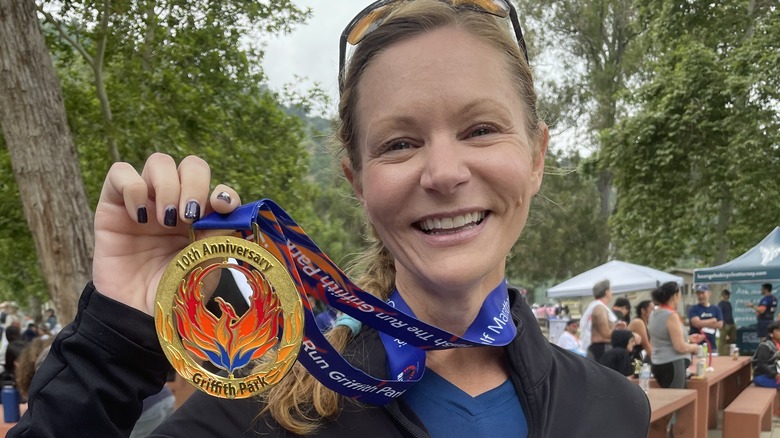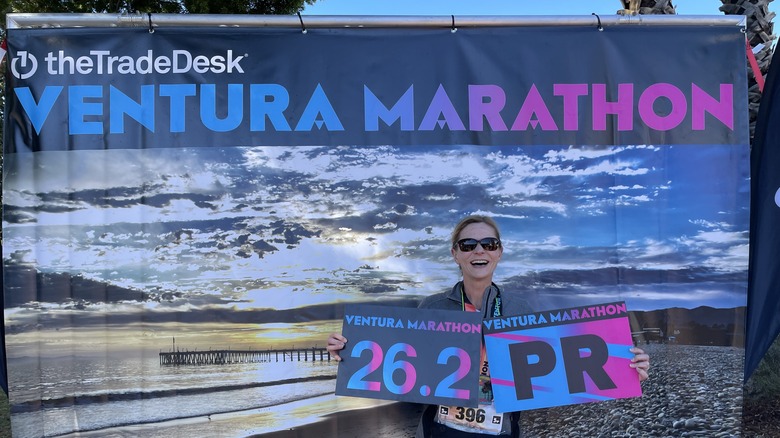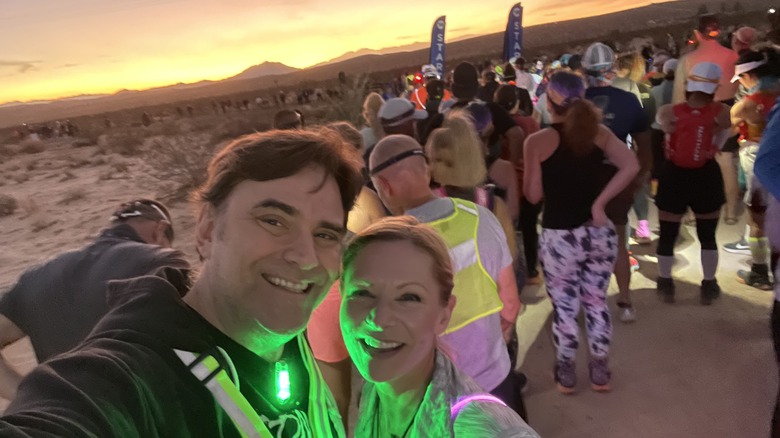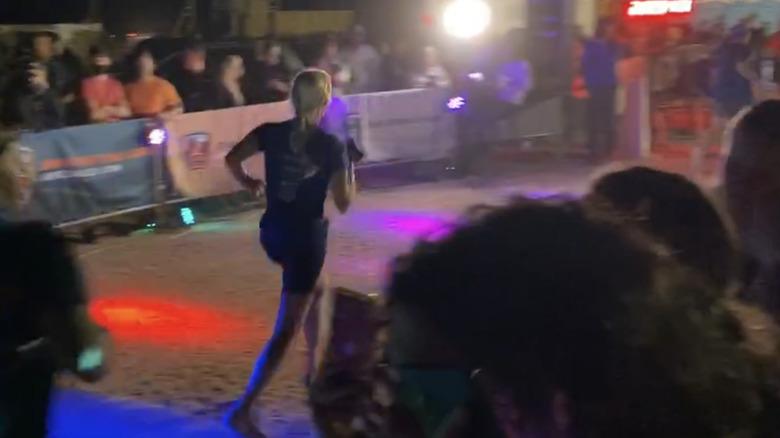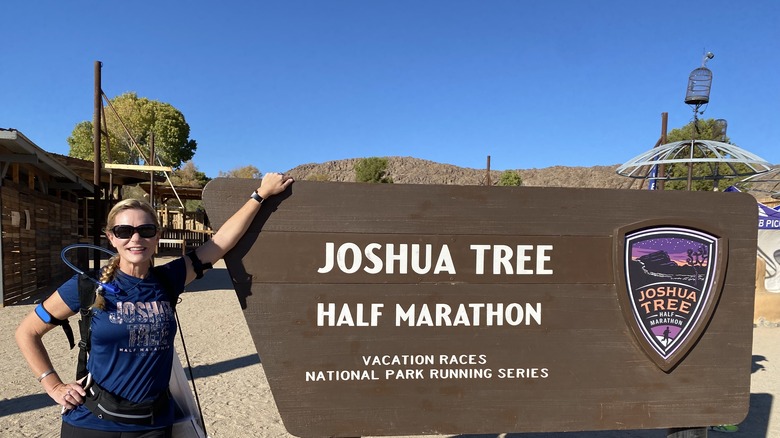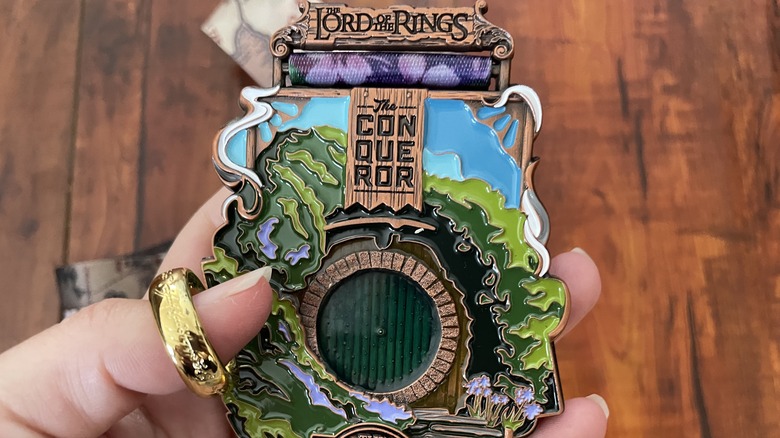I Run Marathons And Here's A Secret, You Can Walk It, Too!
We may receive a commission on purchases made from links.
If doing a marathon or a half-marathon is on your bucket list, now is a wonderful time to sign up for one. I started racing about four years ago, and it changed my life. I ran myself off of three blood pressure medications and recovered from major surgery because of it, and like any friend you have who runs, I talk about it constantly. As part of that talking, I will tell you a little secret: Not everyone runs every second of every race. In fact, some people walk the entire thing.
Don't get me wrong. I run like a crazy person. I love it with all my heart. It reduces my stress, gets me out of the house daily, and, frankly, saved my life. Over the last few years, I've become an advocate for running ... but also for movement of any kind. One response I hear all the time is, "I could walk all day, but I just hate running." That is completely okay, and friends, there are a lot of races out there that allow you to walk the whole event.
This doesn't just apply to full marathons, which are 26.2 miles. You can do a half (13.1 miles), a 10K (6.2 miles), or a 5K (3.1 miles). You can do a huge one like the LA Marathon (or half-marathon) or a small race in your neighborhood. There are also virtual races that allow you to do your mileage whenever you like, whether you run, walk, bike, use a rowing machine, a wheelchair, or slide across your kitchen floor. I'm going to tell you everything you need to know to do a race, no matter how you choose to accomplish it.
The benefits of movement
Let's talk about the benefits of movement on both mental and physical health. The physical ones are well-known. Regular exercise helps build a healthy heart and body function. It helps you maintain vigor as you age and keeps everything working smoothly. Nike posted a study from the American Heart Association which says "brisk walking for 150 minutes a week" can help to reduce the risk of disease, help your cognitive function, lower blood pressure, and increase energy.
I recently spoke to licensed psychologist and author of "It Shouldn't Be This Way: Learning to Accept the Things You Just Can't Change," Dr. Janina Scarlet (who is my writing partner for 13 books), about the mental health benefits of movement. Dr. Scarlet explained in our exclusive interview: "When we move, our body releases certain feel-good chemicals like dopamine and endorphins. And especially when we're struggling with anxiety or depression, these chemicals make us feel better. They give us not only motivation but also a sense of hope. And if we're able to go outside, the ability to be in nature, the ability to see trees and flowers, can make those effects even larger."
By the way, I want to be clear: No specific body type is needed for racing. I have done dozens of races now, and I am telling you that it absolutely, positively does not matter. I have seen every body type, age, and level of fitness race, and all of them have inspired me. As long as your doctor clears you for whichever activity you choose, it's a non-issue. Also, no one cares if you walk or what your pace is. No one is judging you. In fact, you're likely to get high fives and lots of advice and cheers when you tell people it's your first time.
Some races you can walk
Most races will have accommodations for walkers. Any "run/walk" race will, of course, but even some that are advertised as running races leave you enough time to walk. For instance, the picture above is from the Vacation Races Joshua Tree half-marathon in California. Some people run it, but it's set so that you can walk if you choose. While a normal walk pace is usually between 15 and 22 minutes, according to Nike, it's recommended to try to hit between 11 and 15 minutes per mile for optimal benefits. (If you don't run or walk, scroll down because there are races you can do as well!). That leaves you plenty of time, and this race, in particular, encourages walkers to join. In fact, they suggest you at least stop to look back at everyone behind you. It's a night race so you have to wear lights. I highly recommend those if you're not a morning person.
When you're perusing a potential race's website, look for their cut-off pace. For Joshua Tree, it's 16 minutes, but it can be longer or shorter. If you don't finish in time, you can still walk it. They're just not going to hold traffic for you, so you have to be a little more careful if you're on a road.
You can even turn out-of-town races into a mini-vacation. In fact, there are very often beer gardens and parties after (it will say so on the site), so bring some friends. If they're not racing, they can cheer you on with signs on the course. I promise you, racers read every single one, and they really help keep you motivated.
What training looks like
So how do you train for a race? Marathon training lasts about four months on average, but if you're walking, you can do a little less. I recommend picking a distance for a daily walk, like three miles a day for a half-marathon walker. Then do increasingly longer walks each weekend, and time your average mile. You do not have to go fast every time! Jog some of it if you want. Walk it all. Only do fast walks on the weekends. The important part is listening to your body. If you're walking a half-marathon, remember that it's 13.1 miles, so you should at least walk 10 miles twice before the race. Give yourself a day off every week as well.
What do you need for training? Very little, actually. I like a fanny pack, but that's because I bring peanuts to feed squirrels and ravens. Really you just need your phone, some water or sports drink to stay hydrated, I.D., and maybe a little snack like squeezable applesauce. The main equipment needed is walking or running sneakers. I have a favorite type, but there are endless varieties out there. You don't need to spend tons of money, and outlet malls are a great place to find them if you don't care what color they are. They should be replaced about every 300 to 400 miles, and you'll hit that faster than you think.
The important part of training is not judging yourself harshly. Practice your pace, but don't be tied to it. Lack of sleep, not drinking enough liquid, and temperature can all affect your time. You have months of training, so a few bad days aren't the end of the world.
What it's like to do a race
Dr. Scarlet gives some great advice about being intimidated before you start. In our exclusive talk, she recommended newcomers "Start really small, and that could be walking half a block ... when I was training for a marathon, I started with the C25K [couch to 5K] app. I couldn't run a 5K. I couldn't run a mile, so I started with the smallest training app I could find to just jog for 30 seconds with two-minute walking intervals. You also don't have to run. You can walk the entire distance. That's perfectly fine. If you ever look at people who are running marathons and 5Ks and 10Ks, there is always at least one person walking."
The most intimidating part for me was feeling like everyone else knew what to expect. Most people will be just as nervous as you, and most are up for a friendly chat! I spoke to a couple in their early 80s who gave me great advice: No one cares if you're fast or slow. Everyone wants you to succeed. Fall, and someone will help you. Cry, and someone will hug you, sweaty or not. Fall, and someone will carry you over the finish line.
As for practical tips: Races start early, so hydrate like crazy the night before and eat something easy to digest first thing. (There are almost always facilities on the track.) Dress warmly for a morning race. Most will donate any clothing you drop on the course. Do not skip the hydration stations! If you're walking, just start in the back of the racers. You won't be the only one! When you finish, grab your medal and stretch. Do not skip sleep the next day and take a few days off. You will be sore, but you've earned it.
Virtual races are even more inclusive
What if that all sounds like too much, or you're still avoiding crowds? Virtual races are a great option! These got really popular during the pandemic, and I ran my first two marathons this way. Some use the honor system, some use your fitness tracker, and some let you put in your own miles.
One company that I found is The Conqueror Challenges, which allows you to track or self-report miles, and you can do those miles any way you want, on your timeframe. There are all different mileages, from 26.2 to the five-medal "The Lord of the Rings" challenge, which goes over 1000. You send them the fee, track your mileage on the app, and they send the medal when you're done. You can split the miles with a team, do them together, or alone.
A really important component here is virtual racing Facebook groups or message boards. For instance, the one for The Conqueror has fellow runners with inspiring stories, training hardships, advice, and the most supportive group of people I've ever encountered online. In the exclusive interview, Dr. Scarlet spoke about the importance of community when you're trying something new. Dr. Scarlet suggested, "Having a community can help you motivate yourself when you don't feel like getting out of bed or out of the house. It can allow you to feel proud of your accomplishments. It can remind you that there are other people relying on you so you can all support each other and high-five all the way to the finish line."
You can do this! If you need any inspiration or tips, feel free to reach out to me on social media. I'm very happy to help! You've got this, racer!
